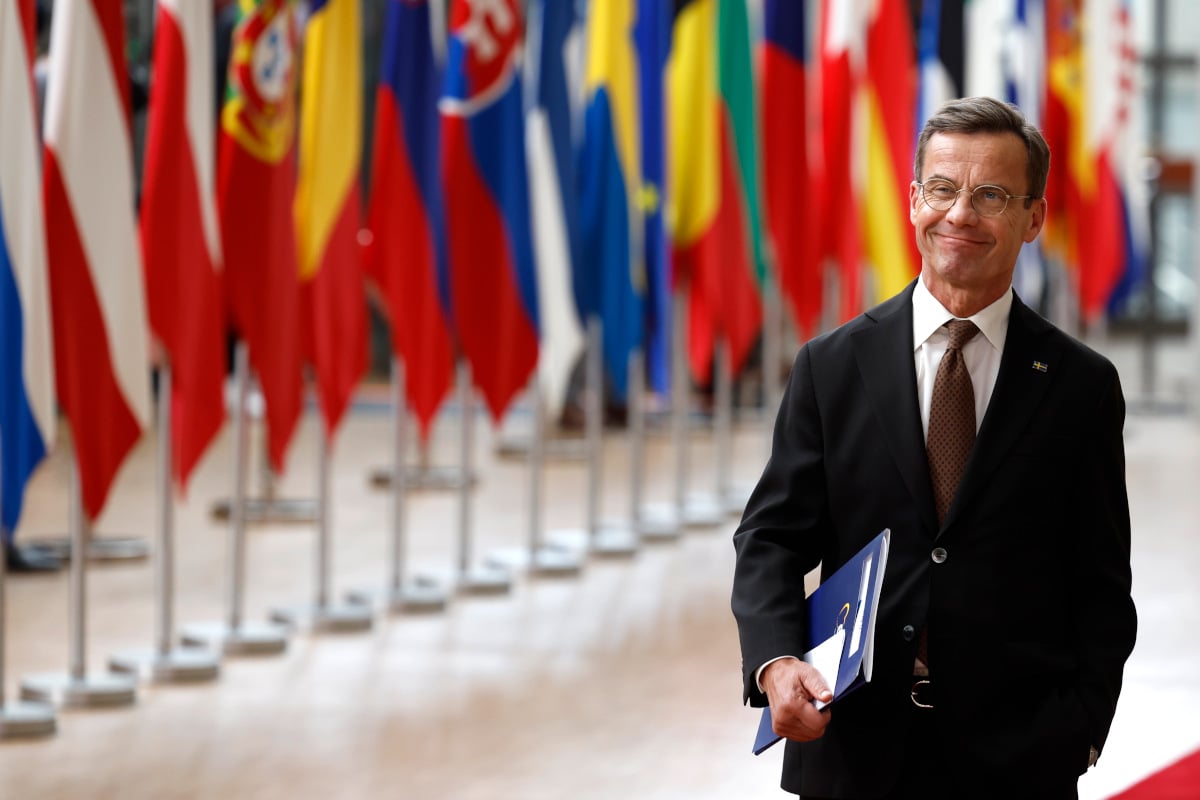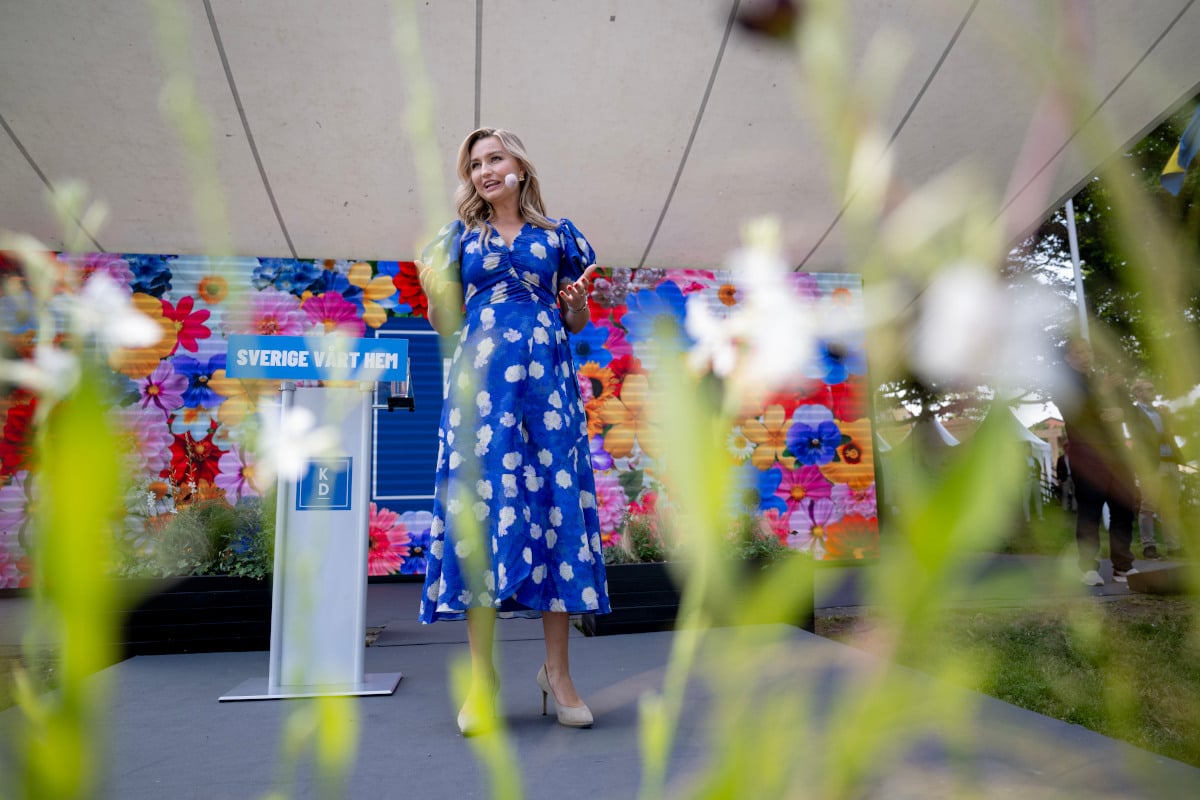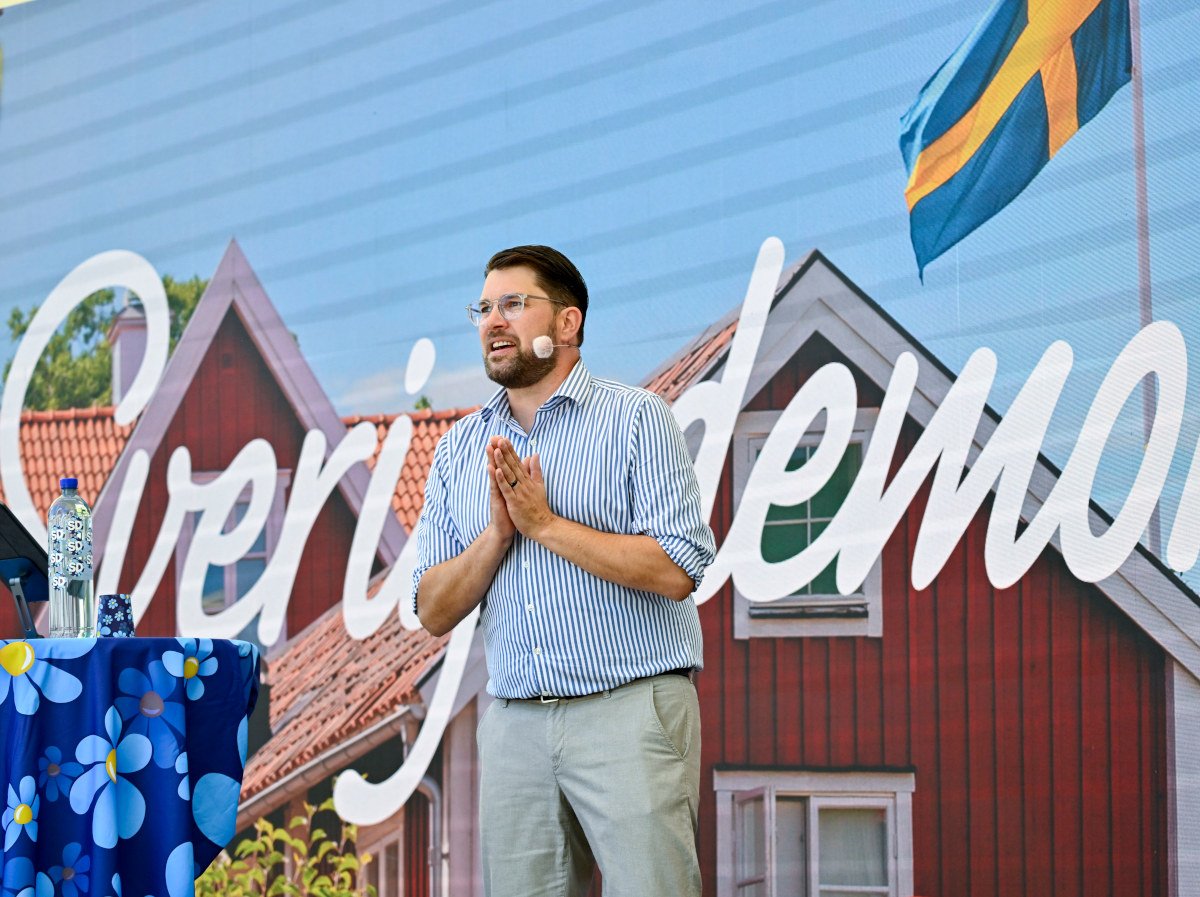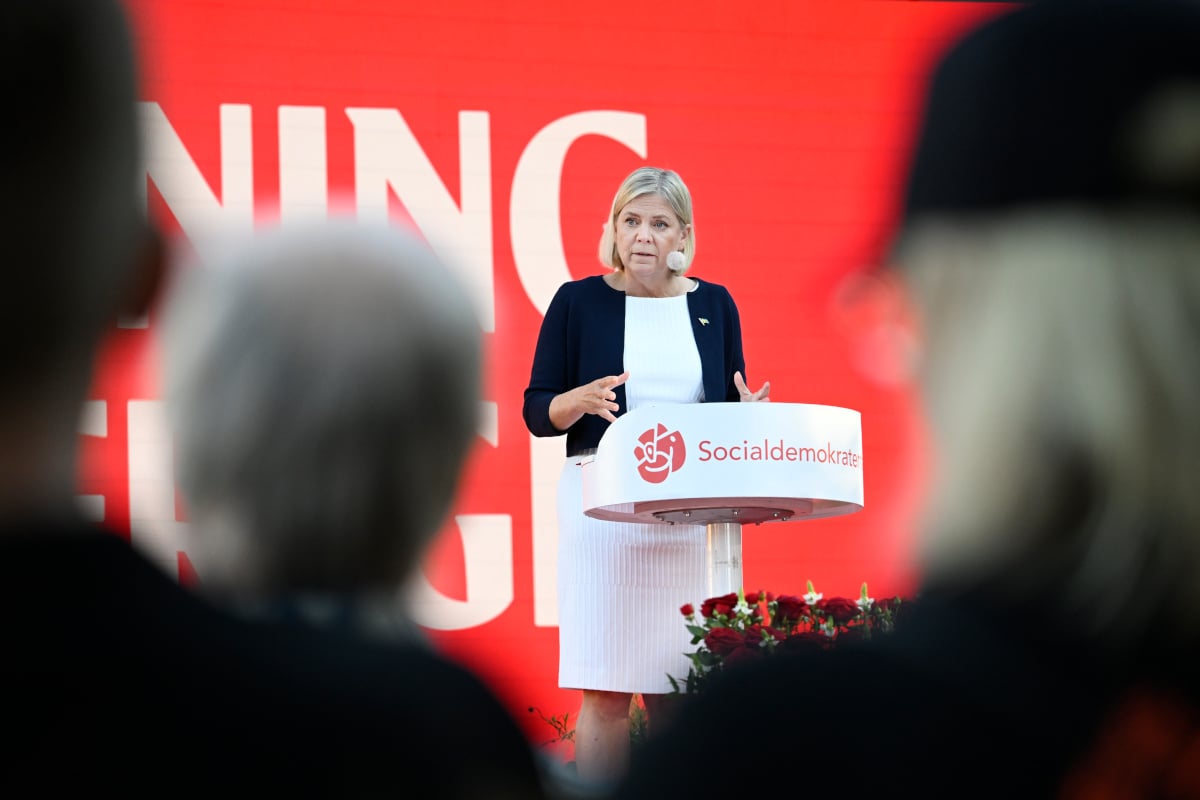THE GOVERNMENT: Moderates, Liberals and Christian Democrats, supported by the Sweden Democrats
Moderate Party (Moderaterna)
Vote share (2022 election): 19.1 percent
Seats in parliament: 68
Leader: Prime Minister Ulf Kristersson
Party letter: M

Background: Ulf Kristersson took over as leader of the Moderates after Anna Kinberg Batra was ousted by the conservative party in September 2017, due to a dip in the polls after the party broke a Swedish taboo by softening the stance towards the anti-immigration Sweden Democrats.
Since then, opinion on collaborating with the Sweden Democrats has now shifted to the extent that Kristersson’s party are now leading a government with Sweden Democrat support.
The dad of three and former finance spokesperson of the Moderates in opposition was minister of social security 2010-2014 in former leader Fredrik Reinfeldt's popular centre-right coalition government, and has been prime minister since the 2022 election.
Party: The Moderates' traditional focus has been on law and order issues, job creation and cutting taxes.
Traditionally Sweden’s second-largest party behind the Social Democrats, the Moderates were pushed down to third place after the 2022 election by the Sweden Democrats, who took second place with 20.54 percent of the vote.
As recently as 2018, the Centre and Liberal parties refused to be part of a government that relied on passive support from the far-right Sweden Democrats, resulting in Kristersson's attempt to form a government failing.
Now, the Centre Party still refuses to work with the Sweden Democrats, but with the Liberals and Christian Democrats on his side, Kristersson is leading a government supported by the Sweden Democrats with a three-seat majority – 176 of Sweden’s 349 parliamentary seats.
Christian Democrats (Kristdemokraterna)
Vote share (2022 election): 5.34 percent
Seats in parliament: 19
Leader: Deputy Prime Minister and Minister for Energy, Business and Industry, Ebba Busch
Party letters: KD

Background: A graduate in Peace and Conflict Studies from Uppsala University, Ebba Busch grew up in the nearby town of Gunsta and has been active in the Christian Democrats since 2006.
She was working as councillor in student city Uppsala when she was chosen to take over as party head from Göran Hägglund in April 2015. Busch has dual Norwegian citizenship through her father, and says she was inspired to enter politics following her mother's bad experience with the Social Insurance Agency after going on sick leave for stress.
Party: The Christian Democrats have tried to move away from their religious roots and build wider support, but the party has struggled to gain popularity. Its increasingly tough stance on immigration has also cost it some of its supporters who back traditionally Christian values.
Areas their policies focus on include welfare for the elderly and healthcare.
The party only just reached the four-percent threshold needed to secure seats in the Swedish parliament in the 2014 election, but increased that to over 6 percent in 2018. In the last election, support dropped to 5.34 percent, but well above the 4 percent parliamentary threshold.
Political parties in Sweden must win at least 4 percent of the vote in order to enter parliament.
The Liberals (Liberalerna)
Vote share (2022 election): 4.61 percent
Seats in parliament: 16
Leader: Employment and Integration Minister Johan Pehrson
Party letter: L

Background: Originally from Örebro, Pehrson was a Liberal MP between 1998 and 2015, and again from 2018 to present. He has a law degree from Uppsala University and took over leadership of the party from former leader Nyamko Sabuni in April 2022.
His leadership and election campaign were characterised by tongue-in-cheek posters and adverts, including images of him wearing clothing popular in the 1980s, with taglines such as "The Liberals have been campaigning for Sweden to join Nato since this tie was modern".
Party: The Liberals often refer to their party as kunskapspartiet or "the party of knowledge", with education and schools a key issue. Other issues important for the Liberals are immigration and integration – where they aim to be open-but-tough – Nato, nuclear expansion, and the EU. They want Sweden to join the Euro.
Their core supporters are middle-class voters.
Approval ratings fell below the Riksdag watermark in April 2015, only increasing when Pehrson took over in April 2022. In the three months between April and the September 2022 election, the Liberals jumped from 2.1 percent to 4.6 percent, just over the parliamentary threshold.
In 2019, the Liberal Party, along with the Centre Party, offered the Social Democrat-Green government passive support in exchange for policy influence in the so-called January Agreement of 2019.
In September 2022, The Liberals agreed to form a government with the Moderates and Christian Democrats, collaborating with the Sweden Democrats, a decision met with heavy scrutiny including from their own youth party.
The Liberals and the Sweden Democrats are the most ideologically opposed parties in the ruling blue bloc, and the government’s time in power so far has not been without clashes between the two.
Sweden Democrats (Sverigedemokraterna)
Vote share (2022 election): 20.54 percent
Seats in parliament: 72
Leader: Jimmie Åkesson
Party letters: SD

Background: An early entrant into politics, Jimmie Åkesson began his career as a city councillor in his hometown, Sölvesborg, in southern Sweden, after joining the party's youth wing as a teenager.
Åkesson is Sweden’s longest-serving current party leader, having led the party since May 2005. Under his leadership, the party has gone from strength to strength – entering parliament for the first time in 2010, and improving on its vote share each year since.
In just 12 years, Åkesson’s party went from being outside parliament to becoming the country’s second-largest party with over 20 percent of the vote.
Party: The nationalist Sweden Democrats were founded in 1988, evolving from far-right organisations with neo-Nazi roots. In recent years the party has worked to tone down its image as a racist and extremist group, although stories of party members making racist or Nazi comments do still occur with some degree of regularity, and there are signs that the party is returning to a more radical profile.
In 2024, a documentary revealed that the party operates a secret "troll factory". This, Åkesson's refusal to apologise, and an opinion piece in which he used extreme rhetoric based on neo-Nazi conspiracy theories, have been mentioned by several experts as factors behind the party's poor result in the 2024 European elections – the first major election in which the party lost rather than gained support.
Cutting immigration remains the party's main goal and it is behind many of the new government’s proposed changes to migration policy.
The Sweden Democrats have received increasing cooperation from the parties on the right since 2018, and in 2021, the Moderates, Christian Democrats and Liberals all opened the door to cooperation. In November 2021, the four opposition parties passed their budget – the first in Swedish history co-authored by the Sweden Democrats – forcing the former left-wing government to rule on a right-wing budget.
Since the election, the Sweden Democrats have used their status as the blue bloc’s largest party to achieve sizeable power despite not being in government, and the party co-authored the Tidö agreement – the coalition document setting out the government’s goals and policies for the next four years.
THE OPPOSITION: The Social Democrats, Left Party, Centre and Greens
Social Democrats (Socialdemokraterna)
Vote share (2022 election): 30.33 percent
Seats in parliament: 106
Leader: Magdalena Andersson
Party letter: S

Background: Magdalena Andersson has been a member of the Social Democrats since 1983 when she joined the youth branch of the organisation as a 16-year-old, being elected chairperson of the Uppsala branch four years later.
She was Sweden’s finance minister from 2014 until 2021, when she took over from former party leader and Prime Minister Stefan Löfven, becoming Sweden's first female prime minister.
Just hours after her election, Andersson handed in her resignation after a tense budget vote threw the government into crisis.
Less than a week later, she was re-elected as Sweden's prime minister, this time leading a single-party Social Democrat government rather than a Social Democrat-Green coalition.
The party were polling at 26 percent in October 2021, shortly before Andersson took over as leader. They achieved 30.33 percent of the vote in the 2022 election, with Andersson's popularity largely credited with the party's success.
Party: The Social Democrats are the oldest and largest party in Sweden and dominated the political landscape until the 1990s. The party promotes workers' rights and built the modern Swedish welfare state, paid for by progressive taxation.
After a crushing defeat in 2006, the Social Democrats continued to lose votes in 2010, particularly from Sweden's urban middle class. The party bounced back after Löfven took over as leader and returned to power in a coalition with the Green Party following the general election in September 2014, but in 2018 the centre-left bloc reduced its lead to just one seat, leading the government to strike a deal with its former opposition, the Liberals and Centre parties.
Despite actually improving their share of the vote in the 2022 election, the other parties in the Social Democrats’ bloc lost support, so Andersson was unable to form a majority government.
This is the first time the Social Democrats have been in opposition since 2014 and only the third time since 1982.
Just like the right wing, the Social Democrats have also toughened their talk on immigration in recent years.
The Left Party (Vänsterpartiet)
Vote share (2022 election): 6.75 percent
Seats in parliament: 24
Leader: Nooshi Dadgostar
Party letter: V

Background: Nooshi Dadgostar took over the position of party leader in October 2020 after Jonas Sjöstedt, who had held the position since 2012. From Gothenburg, Dadgostar now lives in Stockholm. She became active in The Left Party’s youth party in 1999 and was elected a member of parliament in 2014. During her time as an MP, Dadgostar has worked on issues such as housing and higher pensions. She has previously also been the feminist spokesperson for The Left Party.
Since becoming the party’s leader, Dadgostar has proven herself to be a tough negotiator, toppling Sweden’s then-Prime Minister Stefan Löfven in a no-confidence vote just seven months after she was appointed, following a disagreement over proposals to change Sweden’s rental laws.
Löfven was re-elected, but not before the proposal in question was scrapped, giving the Left Party a jump in the polls.
She employed the same tactic in 2021, when Magdalena Andersson was on the cusp of becoming Sweden’s first female prime minister, with the Left Party refusing to back Andersson’s candidacy until she agreed to more generous pensions.
Her tactic paid off again – the Left Party backed Andersson, but only after it had secured the pension reform it wanted.
Party: As its name suggests, the Left Party is the most left-wing group in the Swedish parliament. It has a long history and described itself as communist until the 1990s. The party is against the privatisation of public companies and supports higher taxes to fund Sweden's welfare state.
The Left Party has never served in government but usually offers support to Social Democrat governments whenever they are in power, although they also often criticise the centre-left on issues they don't see eye to eye on.
In the 2022 election, they achieved 6.75 percent of the vote, a drop from the 8 percent they achieved in 2018.
The Green Party (Miljöpartiet de gröna)
Vote share (2022 election): 5.08 percent
Seats in parliament: 18
Leaders (technically “spokespeople”): Amanda Lind and Daniel Helldén
Party letters: MP

Background:
Amanda Lind, who grew up in Luleå in northern Sweden, has previously represented the party as culture and democracy minister in 2019-2021. She took over as co-leader from Märta Stenevi in 2024.
Easily recognisable from her dreadlocks, Lind shouldn't be reduced to her haircut. She is seen within the party as a formidable organiser, and as a minister, she played a key role in bringing in and then lifting Covid-19 restrictions on theatre performances and sports grounds, standing firm and defending her position, despite calls for her resignation from the novelist and comedian Jonas Gardell and others.
Daniel Helldén, the former councillor in charge of transport in Stockholm, is as easily recognisable as Lind thanks to his grey ponytail. He was elected as the party's new leader at its congress in November 2023, taking over from Per Bolund.
Helldén has previously pushed for the Greens to focus primarily on the environment, whereas Lind belongs to the faction of the party that wants it to have a broad focus on all issues.
Party: The Greens first won seats in the Swedish parliament in 1988. The party is focused on fighting climate change and promotes policies designed to protect the planet for future generations.
They had hoped to become the third largest party in the September 2014 elections, but lost out to the nationalist Sweden Democrats. The Greens did, however, enter government for the first time in 2014, after forming a coalition with the Social Democrats, and stayed on in that coalition after the 2018 election, though their share of the vote fell from almost 7 percent to 4.4 – just barely over the four percent threshold for parliamentary representation.
Being part of the coalition didn’t necessarily help them gain support, particularly after the government made a deal with the centre-right Centre and Liberal parties in order to be able to govern in January 2019. In November 2021 they quit the government due to the right-wing opposition's budget passing just a few hours after Magdalena Andersson's election as prime minister and new Social Democrat leader.
As well as clashing with the Social Democrats and the right bloc over environmental policies, from the expansion of Arlanda airport to the question of nuclear power, the other big question has been migration. While the Social Democrats opened up slightly to the right-wing, the Green Party is firmly against proposals like a cap on the number of asylum seekers who can enter Sweden each year.
Since the 2018 election, the Greens have seen even lower support in the polls, although they enjoyed success in the 2024 European elections.
The Centre Party (Centerpartiet)
Vote share (2022 election): 6.71 percent
Seats in parliament: 24
Leader: Muharrem Demirok
Party letter: C

Background: Demirok was born in 1976 in Stockholm and grew up in Vårby Gård in Huddinge, southeast Stockholm. He now lives in Linköping, a city in southern Sweden roughly halfway between Stockholm and Gothenburg, with his wife, his three children and his dog, Allan. He has a political science degree from Linköping University.
He was elected to the Swedish parliament in the 2022 election. Prior to this, he was deputy mayor of Linköping.
Demirok joined the Centre Party in 2002, and has stated that "an important reason for this was the Centre Party's policy for rural areas and for the whole of Sweden".
He describes himself as a lover of nature, especially forests, citing this as one reason behind his interest for the environment. He has also said that his Turkish family were farmers who taught him that "those who use the earth also respect it".
He took over from former leader Annie Lööf, who had been leader of the party since 2011 and was almost synonymous with the Centre Party, in February 2023.
Party: The Centre Party has rural roots, emerging from Sweden's Farmers' League, which was set up more than one hundred years ago, and while agricultural and environmental issues remain key concerns alongside allowing local communities to make their own decisions, the party has tried to attract urban voters more recently by promising help for small businesses and criticising tough work permit rules for foreigners.
They won 8.6 percent in the 2018 election, their best result since 1998, but the centre-right bloc still failed to get enough votes to govern, partly due to Sweden Democrat gains.
In the run-up to the 2022 election, the Centre Party differentiated themselves from the other parties on the right, by refusing to co-operate with the Sweden Democrats.
This didn’t necessarily pay off for them – they dropped from 8.6 percent to 6.7 percent – and Lööf stepped down soon after the election. She said that her decision had been partly influenced by the threats and abusive posts online she faced since even before leaving the right-wing Alliance and giving her party's support to the Social Democrats.
Demirok has fared even worse in the polls, and a running gag on satirical Swedish politics show Herr Talman is that voters simply have no idea who he is.
Politics in Sweden is The Local's weekly analysis, guide or look ahead to what's coming up in Swedish politics. Update your newsletter settings to receive it directly to your inbox.

Join the conversation in our comments section below. Share your own views and experience and if you have a question or suggestion for our journalists then email us at [email protected].
Please keep comments civil, constructive and on topic – and make sure to read our terms of use before getting involved.
Please log in here to leave a comment.